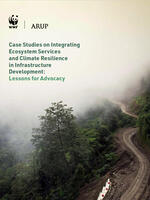Case Studies on Integrating Ecosystem Services and Climate Resilience in Infrastructure Development: Lessons for Advocacy
-
Date:
October 01, 2019
-
This publication relates to:
With support from GIZ, WWF and Arup conducted a review of innovative practices across several regions of the world that integrate both ecosystem services and climate change projections in planning and design. With 60% of the land expected to be urbanized by 2030 yet to be built, alongside an estimated 25 million km of new roads by 2050, there is urgent need to identify and replicate practices that preserve ecosystem services and mitigate the expected effects of climate change. Reviewing more than 90 cases of infrastructure planning or design, this report presents three brief case studies in developing economies to highlight recent advancements in such integrated approaches: the Mexico water supply system, the LAPPSET development corridor and Lamu port in coastal Kenya, and the Shenzen sea wall. It also highlights a number of innovative examples in the US and UK as examples to learn from to inform improved infrastructure planning moving forward.
The report summarizes important conclusions and recommendations for improving infrastructure development moving forward, including:
- While holistic approaches to infrastructure development at scale is an emerging trend, it has yet to mature;
- More effort is needed to share effective approaches and examples in practice across a diverse group of stakeholders, including industry, NGOs, multilateral financial institutions, and country governments to demonstrate the business case.
- There is an opportunity to shape the convergence of different approaches and frameworks in order to standardise them across institutions and simplify complex planning considerations for practitioners.
- A review of global standards and frameworks for decision-making and investment design could advance the agenda. This could be promoted under parent global processes like the Paris Agreement, CBD, UN Sustainable Development Goals, etc. The design and construction industry would likely follow and contribute actively.
- A holistic approach to the lifecycle of the infrastructure across themes as complex as ecology and climate change, should require procurement to adapt: this means including these topics fully in tender notes, procurement processes, budgets, and, ultimately recruitment and management.
- Advocacy must make efforts to prove that costs for planning and designing sustainable infrastructure with holistic approaches, are amply justified over the mid to long-term.
- There is also a clear role for designers and practitioners to play in influencing the ‘clients’ who are funding or implementing infrastructure projects.
- Each of the case study examples demonstrates the important of strong stakeholder relationships which are often made more complex by the holistic approaches, and which may not correlate directly with lines of responsibility or governing boundaries.
- When operating at a large scale, particularly at regional, water catchment or even international level, the coordination and commitment between all stakeholders involved is critical.
